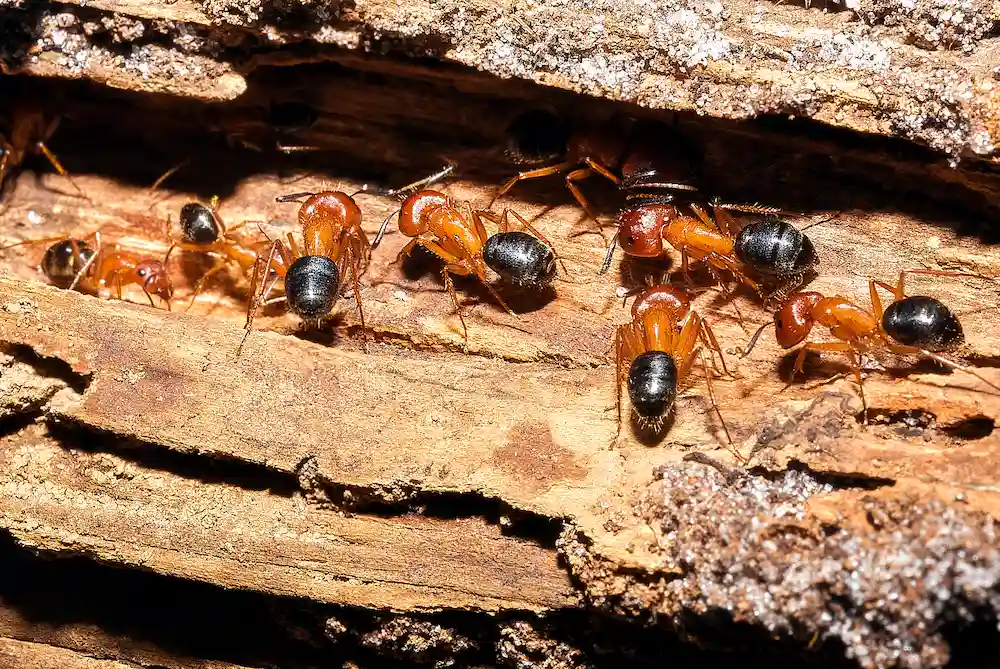Summary: Carpenter ants are incredibly destructive, which makes them a dreaded pest. This blog describes the lives and habits of carpenter ants, as well as the best ways to prevent them. Pointe Pest Control provides thorough solutions for PNW pest issues.
There were lots of great jokes performed during April Fools’ Day, but do you know what isn’t a laughing matter? Carpenter ants! These are some of the most destructive pests in our region. They’re often compared to termites since both pests chew tunnels into wooden structures.
The swarming season for carpenter ants is usually late spring through early summer, so it’ll be here before we know it. The best way to combat a pest problem is to know their life cycles and habits — then use these against them. So let’s dive into the busy lives of carpenter ants to see how their work ethic goes hand-in-hand with their destructive natures.
Carpenter Ant Basics
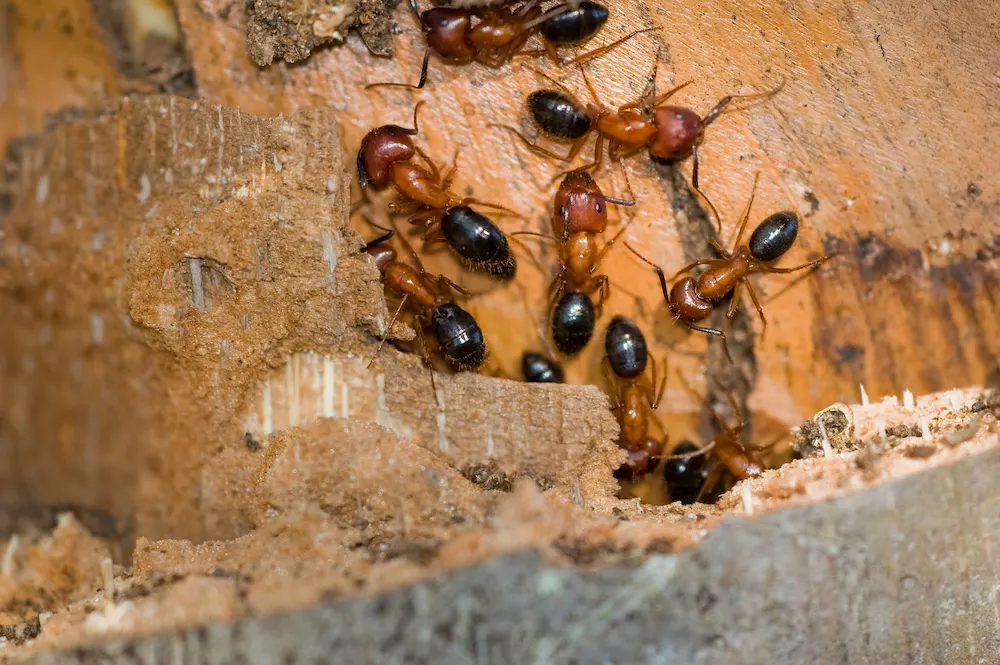
Before we dive into the harmful habits of these ants, let’s discuss the basics. There can be tens of thousands of carpenter ants in one colony. They don’t actually eat the wood they chew through — unlike termites, who do — and just push the extra wood out of their nests. The ants forage for food at night, and their favorites include insects, fruit juice, aphid honeydew, and plant sap.
Carpenter ants have:
- Red, black, or red and black coloring
- A length of 1/4 of an inch to 1/2 an inch
- Strong mandibles (mouthparts) for gnawing through wood
- A heart-shaped head
- A rounded thorax
Flight of the Swarmers
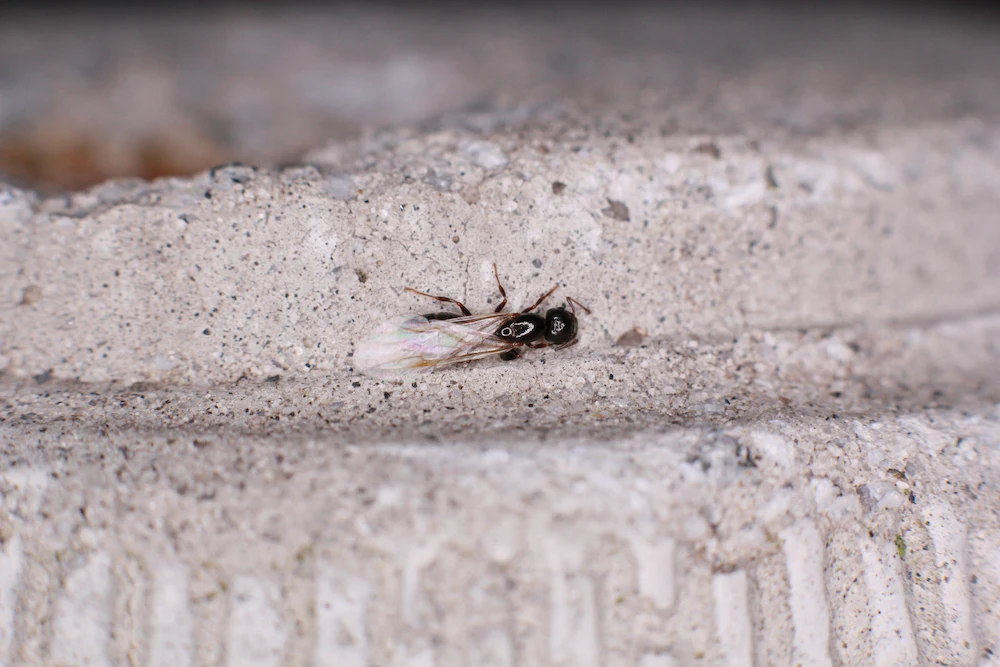
The only carpenter ants that have wings are the swarmers — aka the reproductives. Each swarmer has two sets of wings that they use for flying to new nesting sites. These ants are responsible for growing the colony’s numbers by laying 20 eggs at a time. Swarmers are larger than workers and have longer life spans. Queens can live for 25 years!
In the Pacific Northwest, the swarming season for carpenter ants is late spring through early summer. Now that it’s April, this annual event is right around the corner. Carpenter ants only want to live in damaged wood close to food and water, which isn’t inside homes (at least, for the original nest).
It takes two years for the colony to grow large enough for the queen to start producing new swarmers. If the original carpenter ant problem isn’t solved, you could be dealing with two generations of these destructive pests!
Where Do Carpenter Ants Like to Live?
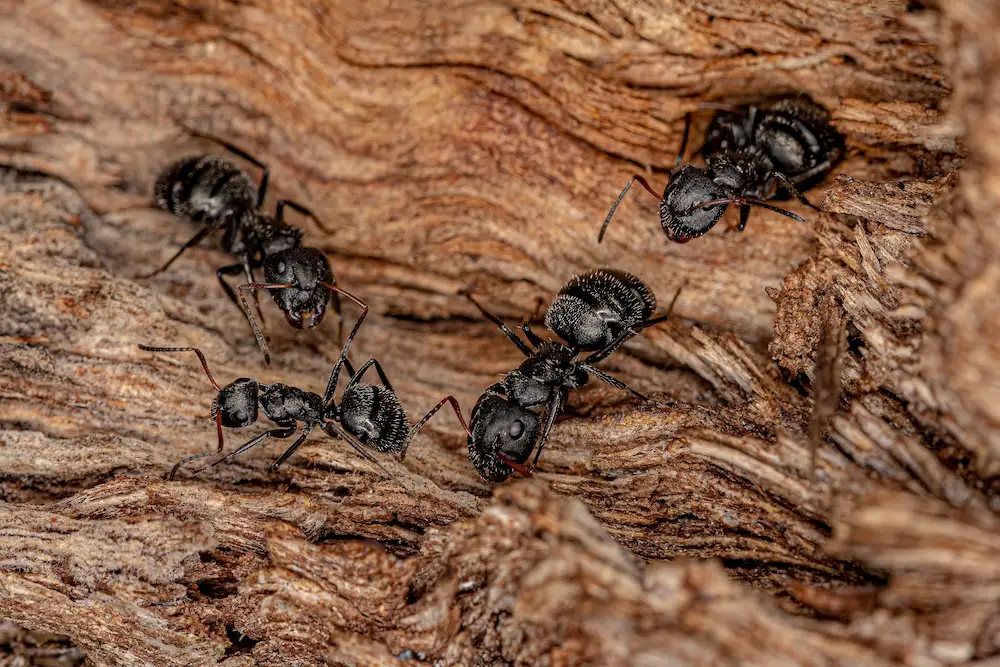
We know that carpenter ants need to live in wood — hence their name — but do they prefer certain areas over others? Of course they do! These ants love moisture-damaged wood. When swarmers search for their new nest locations, they look for wood that’s already rotten or ruined. They want it to be easy to grow their colony, and softened wood is the ideal place.
When carpenter ants invade a house, they usually target the:
- Wall voids
- Flooring
- Spaces near air ducts
- Attic
- Crawlspace
- Wood near plumbing or leaks
Carpenter ants usually prefer to keep their original nest outdoors so they have easy access to food and water. That’s why you’ll often find carpenter ant nests in rotten tree stumps, old roots, rotten firewood, and fallen trees. They also enjoy weathered decks and patios, so keep an eye on your wooden outdoor spaces (more on this later).
The Logistics of Satellite Nests
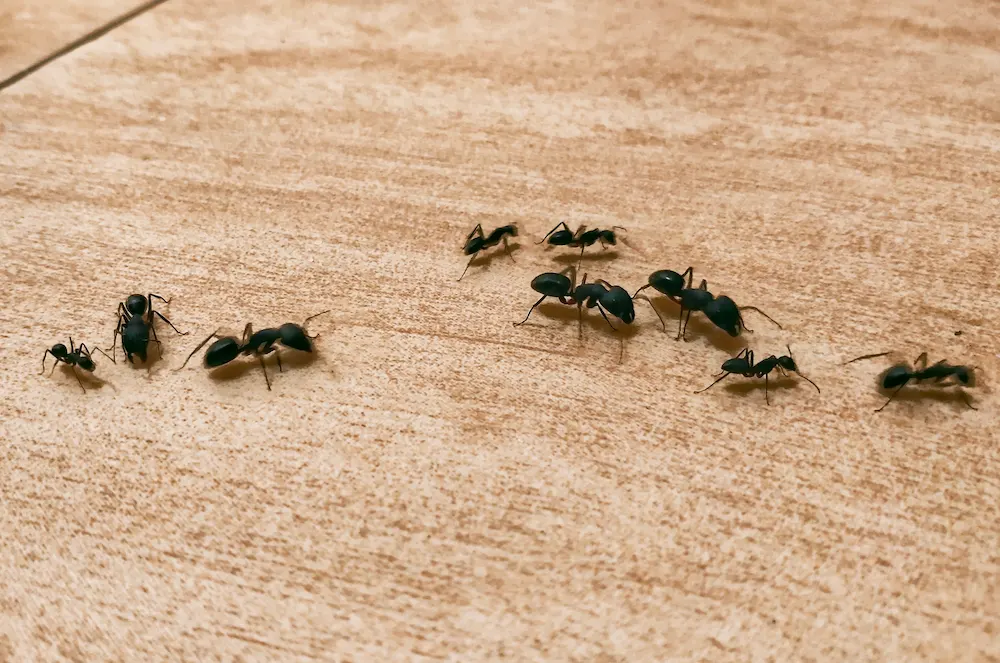
Other eusocial pests do this to a smaller extent, but carpenter ants are the kings and queens of building satellite nests. Essentially, the original nest is in damp wood and contains the queen and eggs. Satellite nests are established hundreds of feet within the original and are contained in dry wood. These are the nests we see in houses and buildings.
Satellite nests are used for food transportation and pupae care. When the original nest is at capacity, worker ants create smaller satellite nests to house the older offspring. These nests are often mistaken for the original nest with the queen. It isn’t enough to eliminate satellite nests. To fully end a carpenter ant issue, every nest in the area needs to be treated.
Risky Pests
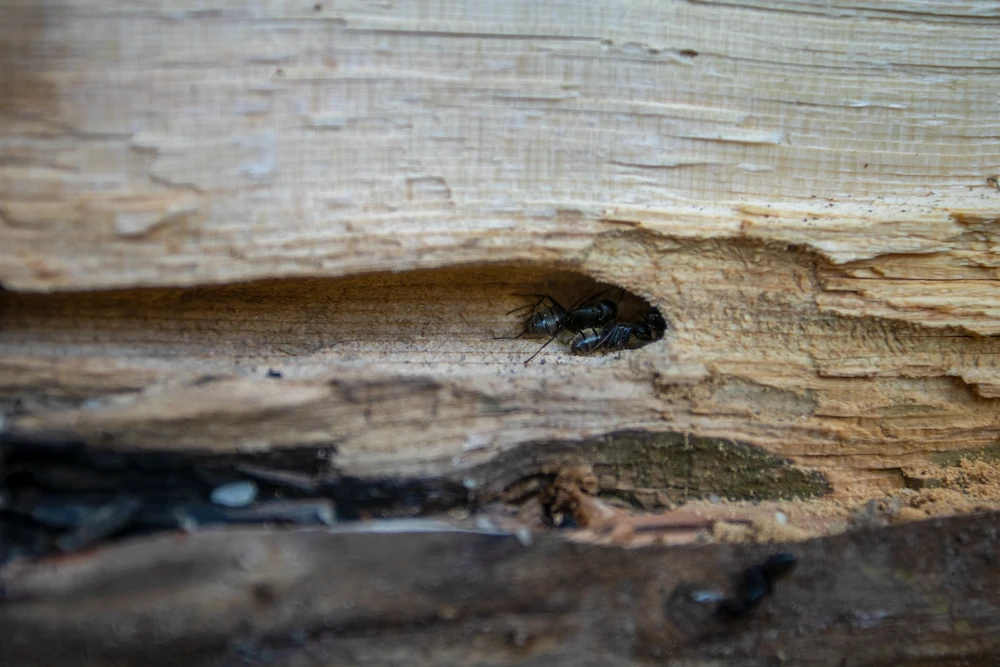
Speaking of which, satellite nests are a big reason why carpenter ants are such a problematic pest. They’re more difficult to fully eliminate than other pests because they divide their massive colonies among multiple nests. Professional pest control technicians are more likely to reach all of the nests than store-bought products are.
Another reason why carpenter ants are such a destructive pest is the — well, the destruction they cause. As the workers chew further into their habitat, that wood becomes weaker and unhealthier by the day. The more tunnels they carve, the more damage the wood sustains. This is a major safety risk when carpenter ants are inside a house’s framework or walls.
The one benefit carpenter ants provide is breaking down wood that’s already rotten. This helps the ecosystem by speeding up the decomposition process. Plus, if you think of it as a positive, a carpenter ant invasion is a sign that there’s a leak or water damage somewhere nearby. Remember: these ants won’t live far from food and water.
However, that’s where the positivity ends. Whether they’re invading our houses or foraging for food in our gardens, carpenter ants are a harmful pest you don’t want anywhere near your home.
How to Prevent Carpenter Ants
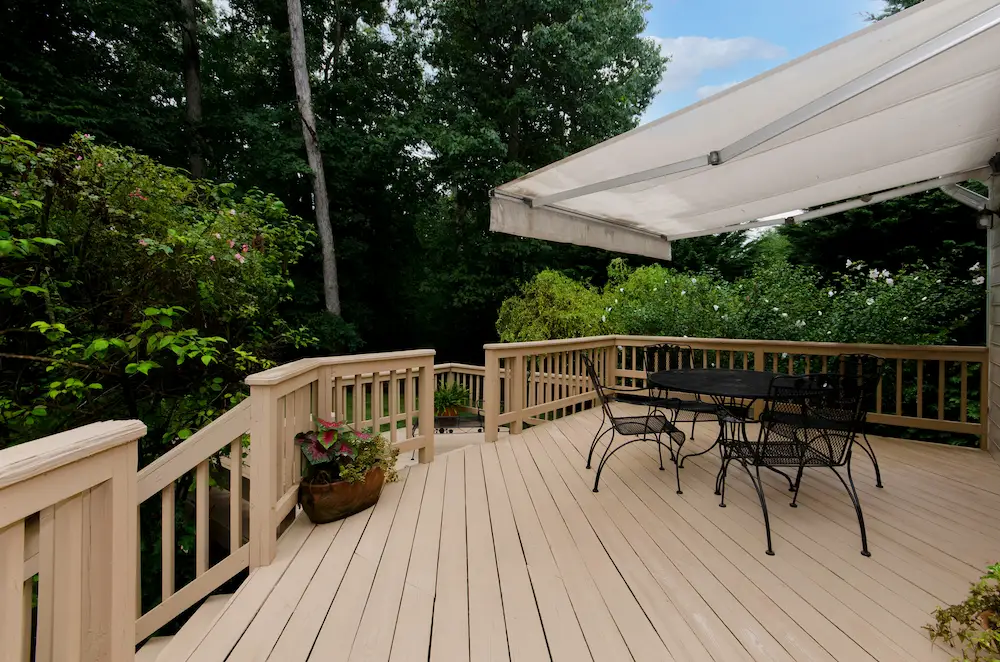
Pest prevention is a key component to being a homeowner. We protect our homes from other kinds of damage, so why not guard it from the creepy-crawlies trying to get inside?
It’s especially important to prevent wood-boring pests, like carpenter ants and termites. It is possible to end major infestations, but it’s much more efficient to treat a small invasion (or prevent it entirely).
Our best tips for preventing carpenter ants are:
- Repair Leaks ASAP — Carpenter ants target damp wood, so eliminate their favorite habitats by searching for leaks in your home and repairing any that you find ASAP.
- Seal Entry Points — Ants can’t get inside if they don’t have an entry point. Inspect your house’s exterior for cracks or gaps regularly. Seal new openings with waterproof caulk.
- Keep Gutters Clear — Clogged gutters and downspouts trap in moisture, so it’s important to remove anything blocking the flow of water through either.
- Maintain Your Trash — This is a good tip for preventing any type of ant, including carpenter ants. Take out the trash when it’s full, and keep the lids to the outdoor trash cans closed.
- Remove Damaged Wood — We suggest never leaving rotten or damaged wood for long periods of time. If any wood in your outdoor items (shed, deck, swings, etc.) is rotting, replace it with fresh wood.
- Look for Signs of Ant Activity — No matter the season, it’s wise to keep an eye out for signs of carpenter ant activity. The common ones are swarmers, holes in wooden materials, rustling sounds, and live or dead ants.
- Contact Pest Control with Swarmer Sightings — The sooner that a carpenter ant problem is treated, the better. Avoid costly repairs by contacting your local pest control provider if you see any swarmers near your home.
Take a Bite Out of Pointe’s Efficient Services
Carpenter ants are just one of many pests that cause problems for homeowners. Instead of trying to solve the problem with insufficient store-bought sprays, leave it to Pointe Pest Control! Our experienced technicians provide targeted treatments and thorough inspections that get to the source of each pest problem. We take pride in protecting Pacific Northwest homes from destructive pests all year long.
Whether you need long-lasting solutions or reliable pest prevention, Pointe is here for you. Contact us today for a free quote on our professional services — you’ll be glad you did!
Citations
Carpenter ants. (n.d.). ProSite. Retrieved March 21, 2025, from https://www.prositepestcontrol.com/carpenter-ants/
Carpenter ants 101. (n.d.). Pest World. Retrieved March 21, 2025, from https://www.pestworld.org/news-hub/pest-articles/carpenter-ants-silent-destroyer/
What do carpenter ants look like, and do they have wings?. (n.d.). United Pest Solutions. Retrieved March 21, 2025, from https://www.unitedpestsolutions.com/common-pests/ants/what-do-carpenter-ants-look-like-and-do-they-hav/

